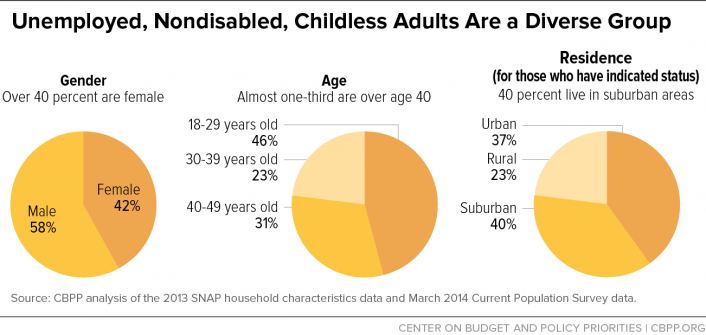BEYOND THE NUMBERS
Thousands of the nation’s poorest people began losing SNAP benefits (formerly known as food stamps) on April 1 due to the return in nearly two dozen states of a three-month limit for unemployed adults aged 18-49 who aren’t disabled or raising minor children. Over the course of 2016, as many as 1 million such individuals may lose their food assistance benefits after three months regardless of how hard they’re looking for work.
Federal law limits these people, some of the nation’s poorest, to three months of SNAP out of every three years unless they’re working at least 20 hours a week or participating in a work training program at least 20 hours a week.
As we’ve explained, this is a diverse population, many of whom have multiple barriers to independence and self-sufficiency. Over 40 percent are women and close to one-third are over 40 years old. Among those who report their race, about half are white, a third are African American, and a tenth are Hispanic. About a quarter have less than a high school education, and more than half have only a high school diploma or GED. Some are veterans, and some are non-custodial parents. They live in all areas of the country, and less than 40 percent live in urban areas. (See chart.)
While some in this group experience long spells of deep poverty or chronic homelessness, many others cycle in and out of work, often in low-paying jobs that don’t lift them out of poverty, as the Washington Post recently noted. The nation’s safety net offers meager assistance while they’re working, and virtually none when they’re not. SNAP benefits for this group, which average only about $5 a day, are one of the few forms of support they can get. The three-month benefit limit will impose serious hardship on many of them.
States can request that the federal government waive this time limit in areas of high unemployment, and most have done so since the late 1990s. Most states waived the time limit statewide during the recession and slow recovery. But these statewide waivers are largely expiring as unemployment falls, leaving most states eligible only to waive counties with high unemployment.
This year, over 40 states will be implementing the time limit, including 23 that are implementing it for the first time since before the recession. Several states including Arkansas, Florida, and Missouri aren’t seeking any waivers even for their high- unemployment areas that would continue to qualify for a waiver, exacerbating the impact on their poor citizens.
Cutting off food assistance to poor unemployed and underemployed workers doesn’t help them to find a job or secure more hours of work. No one should lose food assistance because they can’t find a full-time job.

